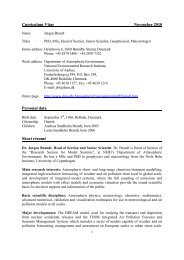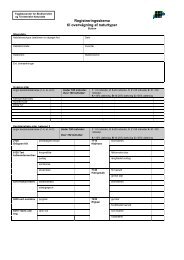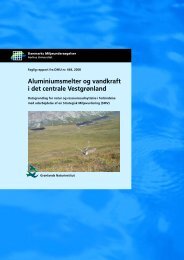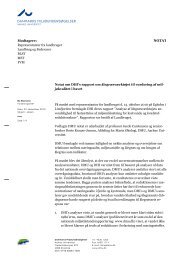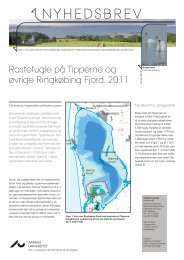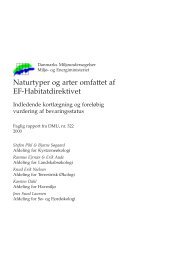Spatial distribution of emissions to air - the SPREAD model
Spatial distribution of emissions to air - the SPREAD model
Spatial distribution of emissions to air - the SPREAD model
You also want an ePaper? Increase the reach of your titles
YUMPU automatically turns print PDFs into web optimized ePapers that Google loves.
*HQHUDO PHWKRGRORJ\<br />
The <strong>distribution</strong> <strong>of</strong> <strong>emissions</strong> in <strong>the</strong> Danish emission inven<strong>to</strong>ry is carried<br />
out in databases and in <strong>the</strong> geographical information system ArcGIS.<br />
The methodology applied in <strong>the</strong> part <strong>of</strong> <strong>the</strong> <strong>distribution</strong> carried out in<br />
GIS is shortly described in this chapter. The description is made for <strong>the</strong><br />
Industrial Processes sec<strong>to</strong>r as case, as this <strong>distribution</strong> is ra<strong>the</strong>r simple.<br />
The emission inven<strong>to</strong>ry for Industrial Processes covers both point<br />
sources and area sources. Emissions from point sources are allocated <strong>to</strong><br />
<strong>the</strong> coordinates given in <strong>the</strong> Danish emission system and are not relevant<br />
in relation <strong>to</strong> <strong>the</strong> GIS procedure. Emissions from area sources are calculated<br />
from production statistics and <strong>the</strong> resulting <strong>emissions</strong> are national<br />
<strong>to</strong>tals as allocation <strong>of</strong> <strong>the</strong> sources (industrial plants) is not possible with<br />
<strong>the</strong> present data foundation. Instead a proxy for <strong>the</strong> <strong>distribution</strong> is applied,<br />
in this case <strong>the</strong> location <strong>of</strong> industrial areas as given in KORT 10 by<br />
<strong>the</strong> National Survey and Cadastre (Figure 2.1). The GIS map <strong>of</strong> industrial<br />
areas is not reflecting differences in <strong>the</strong> location for different industries,<br />
but only holds industrial buildings (referred <strong>to</strong> as <strong>the</strong> industrial area as<br />
<strong>the</strong> buildings are treated as areas ra<strong>the</strong>r than units). The map is a shape<br />
file and <strong>the</strong> industrial areas are polygons.<br />
Figure 2.1 Segment around Avedøre <strong>of</strong> <strong>the</strong> map <strong>of</strong> industrial areas.<br />
As <strong>SPREAD</strong> gives <strong>emissions</strong> on 1x1 km <strong>the</strong> map <strong>of</strong> industrial areas must<br />
be combined with <strong>the</strong> Danish 1x1 km Grid Net. The grid is an orthogonal<br />
coordinate system where <strong>the</strong> cells are defined and named by <strong>the</strong>ir lower<br />
left corner coordinates, e.g. 1km_6 495_735 where 1km refers <strong>to</strong> <strong>the</strong> cell<br />
size, 6 495 refers <strong>to</strong> <strong>the</strong> Y coordinate <strong>of</strong> <strong>the</strong> grid cell (Y = 6 495 000 m) and<br />
375 refers <strong>to</strong> <strong>the</strong> X coordinate (X = 375 000 m). The grid net map is a<br />
shape file and <strong>the</strong> grid cells are polygons (Figure 2.2).<br />
13





